![]()









CIRCUMSPECT initially developed from playing around with sensations of moving, if not, at the least, with thinking, forward and backward in a time sequence.
There are some ways of thinking about a sounding in relation to the gravity of a pulse.
IMAGINE A STEADY PULSE:![]()
AND, IMAGINE THE MOMENT OF THAT PULSE AS CIRCULAR:
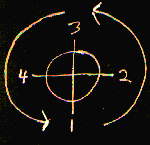
Here are 4 orientations from which one might percieve a sounding in relation to a pulse...
1234 1234 1234 1234 1234
A SOUND MAY ARRIVE...
1.WITH
 THE PULSE
THE PULSE
3.OPPOSITE
THE PULSE
4.BEFORE
THE PULSE
2.AFTER
THE PULSE
Each of these relationships carries a distinct gravitational feel.
1...
Think about THE pulse as where it falls - - - the DOWNbeat. Think about binary yin/yang activities such as breathing (walking, heartbeats, bouncing...) The downbeat falls (as in the release of exhalation),
...3
but the UPbeat lifts, and requires effort, force, that moves against the tendency of gravity (as in inhaling...) The upbeat/backbeat gathers tension which gets released back into the succeeding downbeat.
...4
In between these two poles, there's the effect of arriving, not symetrically at a 180 degree opposition to a pulse, but, just AFTER that ... and also just ahead of the beat, with the sensation of fall/leaning TOWARD/INTO THE PULSE.
...2
Sounds that arrive forcefully just behind the pulse tend to bounce off, SURPRISE, lift and kick... SPLASHing against the thrust of the wave.
ONE COULD ALMOST THINK ABOUT THESE AS BEING CARDINAL POINTS OF SENSATION...
...and opens up a whole subject about how the rhythmic gravitational relationships between sounds (irrespective of the meter and all that...) are the means by which music's sculpturality gets put into effect, that the kinetic shapes are...
I began
forming
CIRCUMSPECT
around a four tone repeating pattern: 
Then, moving backward
through the pattern, I drew this line: ![]()
Which, when the two lines are played simultaneously, the new line sounds as a 3/8 against the 4/8 of the core pattern (a 4:3 relationship).
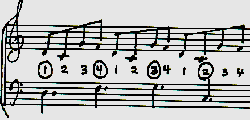
Reversing direction, the process brings out this:

This new line sounds as a 5/8 against the 4/8 (a 4:5 connection) and is also, it turns out, an augmentation, you know, the same melody, but slower, of the core melody.
...right, and the first phrase above is a retrograde of the core melody - for those who like these kinds of words...
Put together, these bass phrases of 3s and 5s can be arranged into a nice set of 4 measures of 4/4:
![]()
THE HARMONIC RELATIONSHIPS between these two melody lines is what I like to call today transparency, which usually means that they intersect at various moments as pitch unisons (unless I'm deciding to do something else at that moment...) and go wherever else they want to imply otherwise.
This offers a lot of compositional/textural/improvisational FLEXIBILITY and can lend to pitched melodic polyphonic writing some of the translucence often enjoyed with ensemble percussion.
I was working with this opportunity all the way through the composing of CIRCUMSPECT.
THEN I gave the core pattern what I might like to think of as a Basie treatment, by which I would mean paring down, removing, simplifying to clarify what's there and to more effectively kick the silences.
I trimmed and cut the repeating pattern until I arrived at something that was also much more interesting than what I'd had to start with. I also got with this my first rough sketch of an impression of a Gnawa sound (This was long before I'd gotten to Morocco or even knew what a guimbri looked like, etc....), which I'd been incidentally going for.

This figure opens the playing of CIRCUMSPECT with the "pitched" instruments playing the line in unison. The traps, in allusion to the Gnawa sound, develop a sound field in a triplet relation to the principle melodic figure. With a larger ensemble than the recorded trio setting, there's the possibilty of layering improvised transparencies in this section like this:
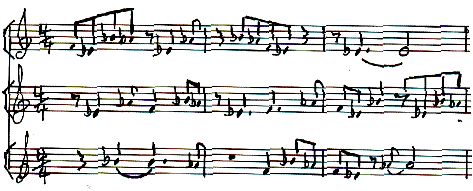
...for example.
The derived bass melody becomes the principal reference point for the next large body of the composition. There's a suspense that goes with this forward/backward 3/8 - 5/8 vs. 4/4 kind of movement and I wanted to intensify it. I pulled on the idea of arch form as often used by Bartok (for example, ABCBA...I like the cycles and loops) and added 4 tones to a B variation, and then 4 more for the C, working out like this:
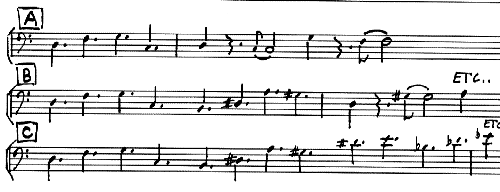
A 4 measures
B 8 measures
C 12 measures
B 8 measures
and round and round. ...in this case it always sounds like it's entering, but there's a suspense as to how far/long it will go... . This becomes the reference breathing pattern for most of what goes on via the composition.
The next melodic strata is written via transparency with this bass melody. But, whereas the bass voice is implying 3/8 and 5/8, this "lead line" tends to emphasize the 4/4 tendency so as to better distribute the tensions between these metric tendencies. Here are the first 4 measures:

There's melody of this sort extended all the way through the ABCB of this.
Then, I wanted to see if I could push this still farther. And, I was feeling my way through the bass line, playing with different angles of attack from a countermelody that could change the meaning of that bass line rhythmically and then some. This is what I drew for those same first 4 measures:
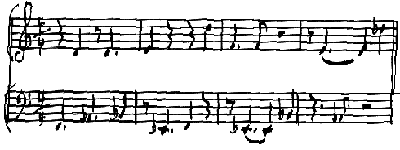
and on ABCB...this gave us still something more to sink our teeth into.
After various statements and restatements and counterstatements regarding these materials, and on to further improvisation, the ensemble winds down to an a capella bass improvisation (played beautifully by Rachiim Ausar-Sahu on our trio recording of this on which way what) that pulls the music onto to still more extensions of some of these countermelodies, first by filling out the outlines of the countermelody as below:
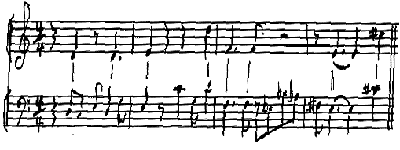
...which became the bass melody underlying the next layer of ABCBs and to which I added still another countermelody to that:

and so forth...